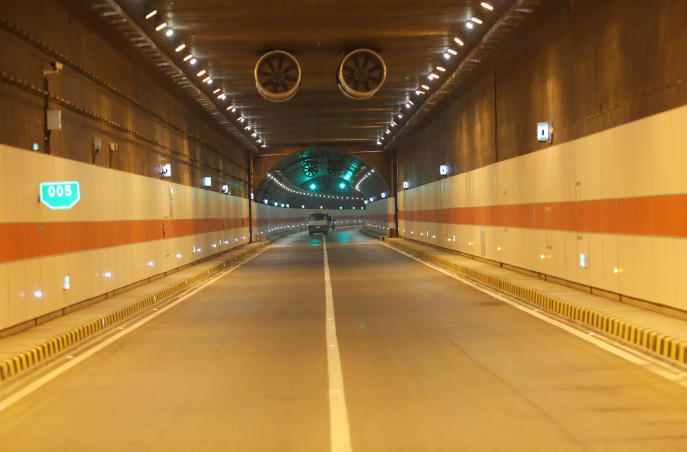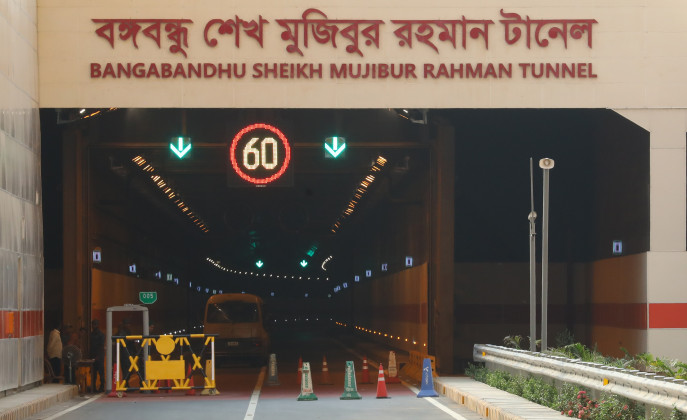Bilal9
ELITE MEMBER

- Joined
- Feb 4, 2014
- Messages
- 26,569
- Reaction score
- 9
- Country
- Location
Chattogram District Administration organized a tour for media personnel through the 3315-metre-long tunnel for the first time on 26 October.
A microbus entering the Bangabandhu Sheikh Mujibur Rahman Tunnel on 26 October 2023. Photo: Mohammad Minhaj Uddin/TBS
A microbus entering the Bangabandhu Sheikh Mujibur Rahman Tunnel on 26 October 2023. Photo: Mohammad Minhaj Uddin/TBS
As the wheels of the minibus carrying journalists and media workers rolled forward towards the Karnaphuli River, everyone on the vehicle leaned forward with anticipation. In just moments, they traversed the river and found themselves on a narrow road beneath. Illuminating their surroundings were the gleaming lights of the tunnel.
Despite having heard tales of renowned tunnels worldwide, like the Gotthard Base Tunnel in Switzerland, the Laerdal Tunnel in Norway, the Channel Tunnel linking the UK and France beneath the English Channel, and Japan's Tokyo Bay-Aqua-Line, this was an entirely new experience for Bangladesh.
The sensation of entering South Asia's first underwater tunnel, the Bangabandhu Sheikh Mujibur Rahman Tunnel, beneath the Karnaphuli River in Chattogram, was truly unique

Photo: Mohammad Minhaj Uddin/TBS
The construction of the 3,315-metre tunnel was completed in November last year at a cost of around Tk10,690 crore. Interior security and engineering works were then completed, and journalists and media workers had the opportunity to enter the tunnel for the first time on 26 October. Prime Minister Sheikh Hasina is set to inaugurate the tunnel on Saturday.
Under the supervision of the Chattogram district administration, two double-decker tourist buses embarked on a journey from the Chattogram city, following the outer ring road and Bayezid Link road, transporting media personnel. The objective was to explore the route from Dhaka to South Chattogram, all the way to Anwara upazila on the southern bank of the Karnaphuli River.

Photo: Mohammad Minhaj Uddin/TBS
Upon reaching the tunnel's approach road, the media personnel had to transfer to a smaller mini-bus. Subsequently, the vehicle convoy, comprising the district administration, Special Security Force (SSF), and the Bangladesh Bridge Authority, continued their passage through the tunnel.
As vehicles approach the eastern end of the tunnel from Patenga, the weight scale becomes visible. Along the centre divider of the approach road between the two tunnels, vibrant flower trees provide a warm welcome to approaching vehicles. Following this, passengers encounter the scanner, the yellow rain shelter cover, and the information screen. There is also a flood gate designed to safeguard the tunnel during natural disasters such as cyclones, tidal waves, or floods.
Inside the tunnel, the interior lighting guides the vehicles. The road has a gentle four-metre descent every 100 metres as vehicles progress, with the tunnel reaching its lowest point, at 31 metres, in the middle of the tunnel. Beyond this point, the slope gradually ascends once again in a similar manner. In approximately four minutes, vehicles will reach the Anwara end of the tunnel, a stark contrast to the one to one and a half hours it once took to traverse this route.

Photo: Mohammad Minhaj Uddin/TBS
Advanced lighting technology has been implemented to maintain comfortable illumination as vehicles enter the tunnel. From just a few hundred metres into the tunnel to the far end, it can give the impression that daylight has already broken at that distant point. However, as vehicles continue their journey, lighting conditions will return to normal.
For the first 200 metres at the entrance and the final stretch of the tunnel, special technology is used to harmonise the lighting with the external environment. Furthermore, an intricate system of 28 jet fans, distributed across the two tunnels, ensures proper air circulation and oxygen control. Both lighting and air quality are meticulously managed from a central monitoring station, which adapts these factors in sync with the weather conditions outside the tunnel.
The two tunnels are interlinked through three cross passages inside the main tunnel. At a certain distance, there are microphones, fire suppression equipment, and emergency exits, along with a drainage system in place. Although there is a narrow walkway within the tunnel, disembarking from the vehicle is strictly prohibited.
Initially, vehicles will maintain a speed of 60 kmph, later increasing to 80 kmph as you proceed. Two and three-wheelers are not permitted in the tunnel. At the Anwara end, a total of 15 booths are available for toll collection, accommodating 15 vehicles simultaneously.
The projected lifespan of the tunnel is 100 years, and it is anticipated that the construction costs will be recuperated within 30 years. To operate the tunnel effectively, approximately 500 personnel will be required, although the decision on whether the tunnel will operate 24 hours a day has not been finalised.
According to the project director of the Bangabandhu Tunnel, Md Harun-ur-Rashid Chowdhury, in the event of a vehicle encountering issues or becoming disabled inside the tunnel, the dedicated management team will promptly resolve the situation within a mere 5 minutes. During the initial five years, toll collection and tunnel operations will be the responsibility of the contracting company.
